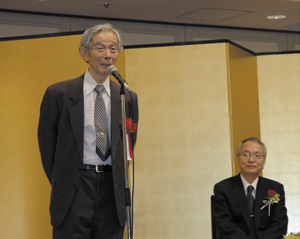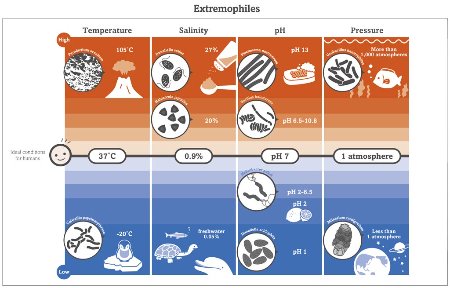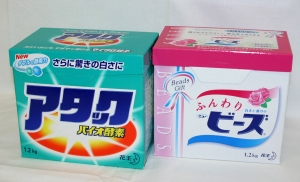Aug. 26, 2016 Impact Biology
Superbugs with superpowers
Organisms discovered in extreme alkaline environments produce enzymes excellent for preserving smells, capturing tastes and cleaning laundry
 Koki Horikoshi (left) and Toshiaki Kudo (right). © 2016 RIKEN
Koki Horikoshi (left) and Toshiaki Kudo (right). © 2016 RIKEN
Koki Horikoshi was an inveterate collector. As a young boy, he would hoard old radios, spending hours pulling them apart and rewiring them to tune in to the latest hits. But his most curious collection, the one for which the world best remembers him, has expanded our understanding of the Earth’s biosphere.
During his lifetime, Horikoshi, who died in March 2016, catalogued the largest number of microorganisms that thrive in alkaline environments above pH 9—conditions that are toxic to humans. It turns out that these superbugs produce some of the most effective enzymes for cleaning laundry and preserving wasabi’s pungence.
A basic diet
Born in Saitama in 1932, Horikoshi first encountered alkaliphiles through a chance experiment as a graduate student in the laboratory of chemist and microbiologist Kin-ichiro Sakaguchi, at the University of Tokyo. Sakaguchi was convinced that sake’s flavor was the product of fungal self-digestion, and so every day Horikoshi tasted the fluids secreted by cultures of fungal strains.
One day in November 1956, Horikoshi was about to undertake another round of tasting, only to find that the fungus in one of the cultivation flasks had disappeared overnight. In its place was the bacterium Bacillus circulans. Horikoshi proved that it had digested the fungus—the first bacteria found to have such abilities. B. circulans smelled of ammonia and grew weakly on a conventional neutral diet, but adding a pinch of basic baking soda increased the broth’s pH, causing the cells to proliferate and produce the mold-killing enzymes.
The discovery, published in two Nature papers in 1958 and 1959, whetted Horikoshi’s appetite for alkaliphiles. But the main course was yet to come.
Extreme living
 Living organisms inhabit the farthest reaches of temperature, pressure, salinity and pH. © 2016 RIKEN
Living organisms inhabit the farthest reaches of temperature, pressure, salinity and pH. © 2016 RIKEN
In 1963, Horikoshi received his PhD and joined RIKEN. By 1968, his research had plateaued, so he flew to Europe for inspiration. In Florence, Italy, he was struck by the architecture, which was so different from the Japanese temples and tea houses constructed during the same period. He wondered whether a radically different environment could influence culture. Maybe even for culturing bacteria.
Back at RIKEN, Horikoshi collected soil samples from sites across campus and incubated them on an alkaline brew. The next day, he discovered a host of alkaliphilic bacteria.
Our skin can deal with a good lathering and a quick rinse of alkaline soaps and shampoos, but prolonged contact is toxic. Before Horikoshi’s epiphany, biologists believed that only the narrow pH range that is tolerable by humans could sustain life.
In the decades since, Horikoshi, who was promoted to chief scientist at RIKEN in 1974, has led groundbreaking studies into the diversity, physiology, molecular biology and genetics of alkaliphilic bacteria, yeast and fungi.
In 1984, Horikoshi led a major government initiative called the Superbugs Project to hunt for living organisms in the world’s most extreme environments. His team pursued extremophiles not just at the upper and lower boundaries of pH, but at the farthest reaches of temperature, pressure, salinity and toxicity. They found crimson, triangular bacteria in the salt fields of the Noto peninsula, and rod-shaped bacteria tolerant to toxic toluene in the forests of Kumamato in southern Japan. In 1996, a submersible scooped alkaliphiles out of the Mariana Trench, more than 10 kilometers underwater. And in 1997, Horikoshi became editor-in-chief of the new academic journal Extremophiles.
Trap and clean
 Kao Attack laundry detergent and Attack Beads with a delightful and long-lasting floral scent. © 2016 RIKEN
Kao Attack laundry detergent and Attack Beads with a delightful and long-lasting floral scent. © 2016 RIKEN
Alkaliphiles and extremophiles are not merely subjects of curiosity; they produce enzymes that have widespread commercial application. Horikoshi discovered two enzymes in particular that have made their way into millions of homes.
The first was a donut-shaped sugar molecule called cyclodextrin, which can make unstable compounds stable, and turn liquids into solids, by trapping compounds in its central hole. But its application had been limited due to the toxic substances required to obtain high concentrations of the product, cyclodextrin.
Horikoshi’s team discovered an alkaliphilic bacteria that could efficiently produce cyclodextrin from starch. The bacteria slashed the cost of producing one kilogram of cyclodextrin from US$530 to US$15. In 1976, a Japanese food manufacturer began mass-producing the enzyme, which is now a staple of many foods, pharmaceuticals and chemicals. It is used to prevent wasabi’s pungent flavor from evaporating, to ensure well-mixed water and fat in butter and margarine, and to transform liquid sake into powder.
In collaboration with the chemical and cosmetics company Kao Corporation, Horikoshi’s team also discovered that the enzyme cellulase could effectively remove dirt stuck to cotton fabrics. They took an alkaliphilic Bacillus bacterial strain that yielded large amounts of cellulase, and used genetic engineering techniques to increase production to an industrial scale. Kao introduced the enzyme to a line of laundry detergents called Attack. Six months after its launch in Japan in 1987, Attack had garnered half the detergent market. Continually improved Attack products are sold today in nearly a dozen countries.
Horikoshi died at 83 in March 2016, but his legacy lives on. “Horikoshi-sensei was a great and wonderful scientist who has inspired many young researchers,” says Toshiaki Kudo, a microbiologist who joined Horikoshi’s RIKEN lab in 1975. Kudo has extracted bacteria from biologically extreme environments such as the termite gut and puffer fish intestines. “We hope to continue his dream of pushing open new research fields.”
